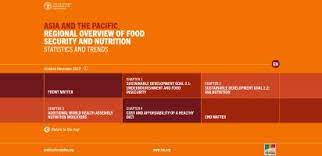
REGIONAL OVERVIEW OF FOOD SECURITY AND NUTRITION 2023

14.12.2023
REGIONAL OVERVIEW OF FOOD SECURITY AND NUTRITION 2023 , Daily Current Affairs , RACE IAS : Best IAS Coaching in Lucknow
|
For Prelims: Key Highlights of the Report,Food Affordability,Undernourishment,Food Insecurity ,Food Insecurity,the Food and Agriculture Organization (FAO),Initiatives are taken by the FAO For Mains Paper:Child Health,Maternal Health,Positive Developments |
Why in the news?
The report from the Food and Agriculture Organization of the United Nations (FAO) sheds light on the state of food security and nutrition in the Asia Pacific region, focusing particularly on India, Pakistan, and Bangladesh.
Key Highlights of the Report
- The Food and Agriculture Organization (FAO) of the United Nations recently released a report titled "Regional Overview of Food Security and Nutrition 2023: Statistics and Trends," painting a concerning picture of food access and nutritional well-being in India and the broader Asia Pacific region.
Food Affordability
- Over 74% of Indians struggled to afford a healthy diet in 2021, demonstrating a significant portion of the population remains vulnerable to rising food costs. The slight decrease compared to 2020 (76.2%) offers a glimmer of hope, but the overall figure remains alarming.
- Rising income inequality and inflation further exacerbate the affordability issue, creating a vicious cycle of poverty and malnutrition.
Undernourishment
- 6% of India's population suffers from undernourishment, translating to economic and social burdens. This statistic underlines the need for robust social safety nets, targeted interventions, and improved access to nutritious food.
- Addressing undernourishment requires focusing on maternal health and nutrition, promoting diverse and healthy diets, and tackling poverty.
Food Insecurity
- While the region's prevalence of food insecurity is lower than the global average, disparities exist. Southern Asia faces higher rates compared to Eastern Asia, highlighting the need for regionalized approaches to food security.
- Persistent hunger and food insecurity threaten human development and stability, requiring urgent action to strengthen food systems and improve access.
Child Health
- 7% of Indian children under five suffer from stunting, reflecting inadequate maternal health and nutrition, poor feeding practices, and repeated infections.
- The high rate of wasting (18.7%) and overweight (2.8%) further underscores the need for comprehensive child health programs and improved nutritional education.
- Addressing these challenges requires promoting early childhood development, advocating for exclusive breastfeeding, and providing access to diverse and healthy foods for children.
Maternal Health
- A staggering 53% of women in India aged 15-49 have anaemia, raising concerns about maternal and neonatal health. This prevalence indicates inadequate dietary intake of iron and other essential nutrients, highlighting the need for targeted interventions and improved access to iron-rich foods and supplements.
- Addressing anaemia requires promoting dietary diversification, improving access to healthcare, and empowering women to make informed choices about their health and nutrition.
Positive Developments
- The slight decrease in the food affordability gap, though small, offers a ray of hope and suggests targeted interventions could yield further improvements.
- India's progress in exclusive breastfeeding (63.7%) surpasses the global average and signifies commendable efforts in promoting early childhood nutrition.
About the Food and Agriculture Organization (FAO):
- It is a specialized agency of the United Nations that leads international efforts to defeat hunger and improve nutrition and food security.
- Its goal is to achieve food security for all and make sure that people have regular access to enough high-quality food to lead active, healthy lives.
- Headquarter: Rome (Italy).
- Member countries: With 195 members - 194 countries and the European Union, FAO works in over 130 countries worldwide.
- Its sister bodies are the World Food Programme (WFP) and the International Fund for Agricultural Development (IFAD).
- Reports published by the FAO: The State of the World's Forests (SOFO), The State of World Fisheries and Aquaculture (SOFIA), The State of Agricultural Commodity Markets (SOCO), The State of Food Security and Nutrition in the World (SOFI)
Initiatives are taken by the FAO
- The Codex Alimentarius Commission is in charge of overseeing the implementation of the Joint FAO/WHO Food Standards Programme.
- Agricultural Heritage Systems of Global Importance (GIAHS).
- Monitors the status of Desert Locusts all over the world.
- The International Treaty on Plant Genetic Resources for Food and Agriculture was adopted by the Thirty-First Session of the Conference of the FAO in 2001.
Source:The hindu